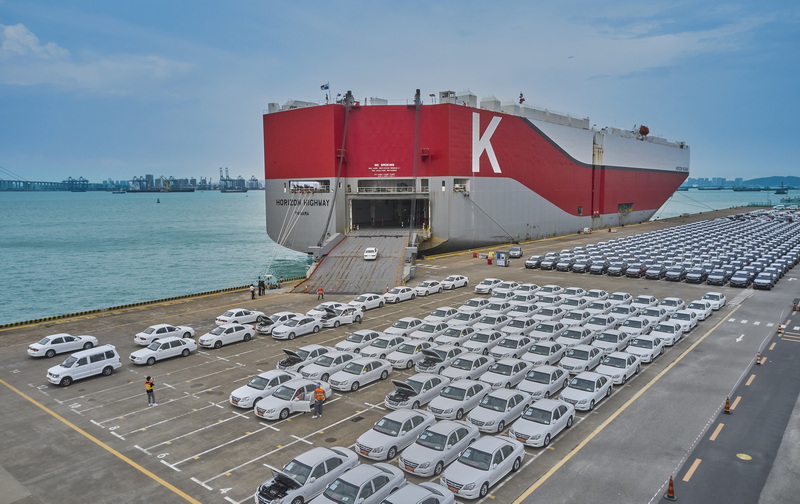China’s automobile export volume realizes rapid growth.
According to data from the China Association of Automobile Manufacturers (CAAM), China’s auto exports were 1.07 million in one quarter this year, up 58.1% year-on-year. In contrast, Japan’s Auto Industry Association (JAIA) data showed that Japan’s auto exports were 954,000 in one quarter, up 5.6% year-on-year. Five years ago, China’s auto exports were still hovering at the 1 million level for a decade suddenly, in 2021~202 it broke 2 million and 3 million consecutively and then rose directly to 5 million in 2023, and if it keeps the export volume at the October level for the remaining two months, the cumulative export is expected to reach 4.9 million units this year.

Considering the trend of increasing exports centred on new energy vehicles in the second half of the year, reaching 5 million units is also possible. If China maintains the current upward trend of exports, it will likely overtake Japan for the first time to become the world’s top automobile exporter.
China’s exports of automobiles by country and percentage of automobiles.
China’s passenger car exports rose 67 % year-on-year, now reaching 3.4 million units, the first three quarters has been the world’s largest auto exporter, cumulative October auto exports reached 4.24 million exports. Data show that China’s auto exports of the top ten countries are Russia, Mexico, Belgium, Australia, Saudi Arabia, the United Kingdom, Thailand, Spain, the United Arab Emirates and the Philippines. Russia became the number one country for China’s automobile exports. However, in 2022, the first place is Mexico, why just one year within the Russian country to buy China’s exports of automobile volume will rise rapidly?

The first reason is that the Russian-Ukrainian issue has led to the replacement of Russian domestic international brands with Chinese cars, and the second reason is that Europe, the United States, South Korea, and Japan do not sell cars to Russia and can only buy cars from China. Even though Russia has a prejudice against Chinese cars, after using them, they found that they are cheap and of good quality, so people started to accept and buy Chinese cars. Once the market share of Chinese cars is broken, it is enough to show that the quality, price and service of Chinese cars are recognized by people. At present, the market share of Chinese cars in Russia is more than 40%. This means that for every three car sellers in Russia, one of them sells Chinese cars.

In the quarter of 2023, Waigaoqiao Haitong Automobile Terminal continued to continue the momentum of last year’s automobile exports exceeding one million units, a total of 231,000 units of foreign trade automobile exports, of which new energy vehicles (electric cars)accounted for 40% of the total exports, the export routes throughout Europe, Southeast Asia, South America and the Middle East. Japan is expected to export 3.8 million vehicles in 2023 and China’s auto exports in the first ten months were nearly 4 million units. October auto exports 488,000 units, up 44.2%, passenger cars exported 421,000 units, with an increase of 50.5%; and commercial vehicles exported 67,000 units, an increase of 14.5%. According to this trend, the remaining two months exports more than 400,000 units per month, the annual broken 4.8 million units no problem, and may even be 5 million units.

From January to October, new energy vehicles (electric cars)exports 995,000 units, an increase of 99.1% year-on-year. This year, Japan’s economic downturn currency depreciation is strong, and car exports are the only bright spot. 2023 January to September, Japan’s auto exports of 31,866,660 units, an increase of 15.8% year-on-year. Among them, 2851267 units of passenger cars were exported, up 19.5% year-on-year, and 3353,393 units of commercial vehicles were exported, down 8.3% year-on-year. Japan’s auto exports for the whole year of 2023 are expected to be 3.8 million units, and China’s are expected to be 4.8 million units. China’s automobile exports exceeded South Korea’s in 2021, Germany’s in 2022, and Japan’s in 2023, the world’s first.

The increase in China’s automobile export volume automobile is mainly due to government support and domestic market innovation and technology.
China’s automobile export growth rate is fast thanks to the government-led vigorous promotion of the impact of new energy vehicles. The second is the competitiveness of China’s automobile products and Europe and the United States market share breakthrough. Due to the low automobile tariffs to create a good condition, the price-performance ratio of Chinese cars is more prominent, which provides convenience for Chinese cars to enter the Southeast Asian market. In the past, Southeast Asian countries have long been the main market for Japanese cars, and along with the signing of this agreement, Chinese car companies have enjoyed exclusive treatment of Japanese cars.

China’s auto exports can develop so quickly; from 5 million cars to 6 million, it only took three months because of the fierce competition in China’s market. In fact, when the rise of Japanese competition is also so, when its own national competition is fierce enough to survive in the competition has been considered a world-class other company, so in the domestic market to do enough to be strong enough, can begin to open up the overseas market, while the various New technology in the automotive industry has begun to gradually penetrate into the automotive manufacturing and driving experience, from intelligent driving to green travel, the automotive industry is experiencing revolutionary changes in quality control, supply chain management and maintenance service system, etc., have a better ability.
Although China has surpassed Japan in terms of sales, it will still rank third in value, behind Germany and Japan. In the first half of this year, China’s automobile exports amounted to 46.24 billion U.S. dollars and ranked first in Germany with 100.82 billion U.S. dollars and ranked second in Japan 55.63 billion U.S. dollars gap. China’s main exports are low- and medium-priced vehicles, of which the amount exceeds the main sale of exports of high-end models of Germany and Japan countries with greater difficulty.

Meanwhile, data analysis suggests that China’s strong auto exports may not last as global combustion-engine car brands are joining the electric vehicle market. Zhang Yongwei, secretary-general of the China Electric Vehicle Association, said China’s electric vehicles lead the world but are not irreplaceable, and the world’s major automakers are entering electric vehicle production. He suggested that Chinese companies should learn from Japan’s experience in entering overseas markets and establish a global supply chain that complies with international trade laws, local cultural environments and international standards.
China is gradually moving in this direction. The sales volume of Chinese cars in the Middle East is very high because the localization of Chinese cars has been done exceptionally well. For example, in Saudi Arabia, Chinese automobile companies have made unique and improved programs for the high-temperature conditions and unique customer habits in the region.
Summary
At present, China’s automobile exports, or a form of trade exports, are the main direction of development in the future or to the destination country for direct investment. The entire supply chain system may also need to go to the localization. I believe that with the increase in our trade mode of exports, our overseas direct investment mode will also enter a stage of rapid development.
If you want to import cars from China, we can provide services, please contact us.


